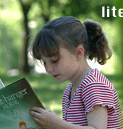To comprehend the texts, you needed to use what you knew in various
ways. You also needed to act on the text in particular ways. The
areas of text processing can be integrated into a model of reading.
It is referred to as the 'multiple levels of text processing' (MLOTP)
model. We read by processing text at a number of levels. This model
is shown in the following diagram.
(Click here to print
the model.)
| Levels of text |
Knowledge of structural text features,
the 'what', conventions of writing |
Reading strategies, 'how to' |
Value of each level; reader's beliefs |
| word level |
word bank containing 3 forms of word: how it is
written, said, means,
- letter clusters, rime families
- types of written words,
- word structures
|
- match text word directly with stored letter cluster knowledge
- convert letter clusters to sounds, blend
- segment words into functional units and recode
|
- why reading/ working out words is useful
|
| sentence level |
- grammar to link words
- sentence propositions (how meanings are linked)
- punctuation, written sentence structure
|
- visualise, paraphrase sentence
- re-read
- ask questions about the ideas,
- listen to ourselves as we read,
- pause and consolidate
|
- how visualising a sentence helps reading
- you can talk about the strategies you use as you read
|
| conceptual level |
'idea bank'; set of ideas linked in
- networks similar to text links
- episodes - contextual links
- linking prose in paragraphs
- paragraph propositions
|
- backtrack / read ahead /within / across sentences to
link concepts
- predict, anticipate, infer ideas, feeling
- What other words might be in text?
- recode imagery to words
|
- why it is useful / interesting to predict
|
| topic level |
- structures used to link ideas to a topic
|
- use title, scan or skim text, select key words to guess
its general theme
|
- why it is useful to note the topic of text
|
| dispositional level |
- values, attitudes intended by a text
|
- how to detect the attitudes in a text
|
- why you need to know attitude of writer
|
Self-management and control strategies
- frame up reasons or purposes for reading a text, plan
how they will read
- monitor our reading, initiate corrective action, decide
when to re-read, self-correct, how they use what they know
at each level, monitor how their reading is progressing,
take remedial actions if necessary and, having read,
- review and self-question to see whether reading goals
achieved, review or consolidate what they have read
- organise the information gained from reading to fit our
purposes for reading
|
|
Existing knowledge |
Oral language knowledge
- at word level, what words mean, how they are said, awareness
of sounds in words
- at sentence level, how ideas are linked into sentences,
grammar.
- at conceptual level, how ideas are linked into themes
- at topic or theme level, how a theme is communicated in
a narrative, description
- at the pragmatic or dispositional level, how the social
context affects how ideas are communicated, the attitudes
and values of the writer towards the ideas in the text.
|
Experiential knowledge
- experiences, visual imagery knowledge
- action, motor knowledge
- knowledge of symbols
|
|
Sensory input to the knowledge base |
Motor aspects of expressive language |
|
Auditory input |
Visual input |
Touch, feeling input |
Motion input |
The 'thinking space' diagram shows the knowledge we use when we
read. At any time readers combine these areas of knowledge in a
dynamic way in their thinking space. They use information from all
of the levels of processing at once, or simultaneously. We can show
the "how to" aspect on reading in this
diagram.
At any time while you are reading, you are retaining various bits
of knowledge in your working memory.
Because we are using several sources of knowledge at once, we can
recognise when the meanings suggested by different sources clash.
This tells us that everything 'doesn't add up' and that we may need
to re-read what we have just read.
An example of the types of knowledge stimulated by a text when
a person reads is shown in this
diagram.

